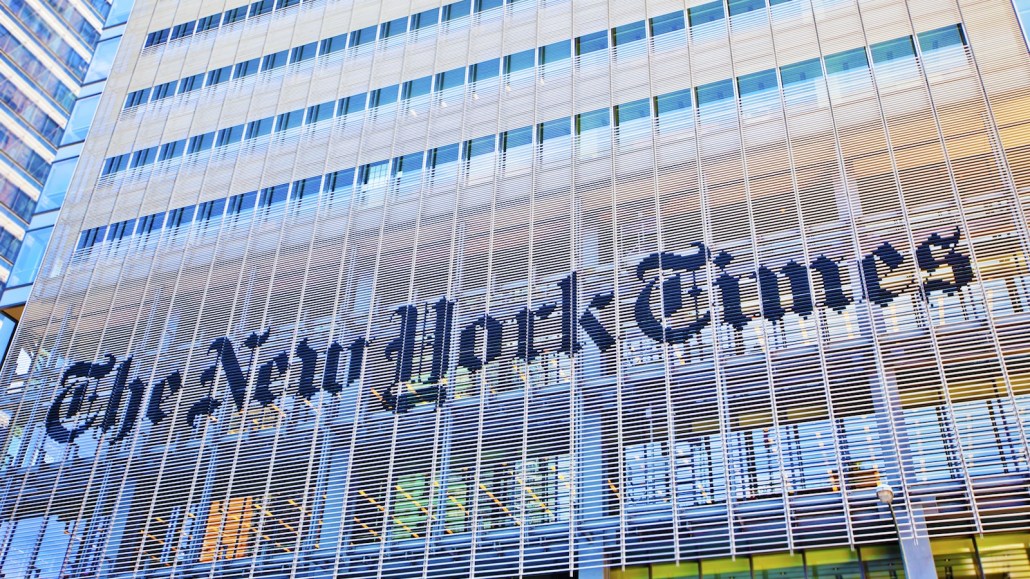
This week, The New York Times takes the wraps off its first Web redesign in five years. Along with the new look, the paper is rethinking its ad strategy, embracing the current trend toward weaving ads more closely with editorial content.
For all the focus on native advertising, the bigger long-term trend is rethinking Web advertising to take it from its historic placement on the periphery of pages. At the Times, this means thinking about “organic” placements within content. For example, one new ad unit the Times is rolling out will appear within the strip of thumbnails and headlines of recent stories that appears at the top of article pages. Another display ad, which the Times is calling a “nested” ad, appears in the middle of longer articles, expanding as the reader scrolls down and subsequently contracting. New multimedia “Snowfall”-style articles will come with advertising embedded beyond standard ad placements on the periphery.
“We are going for organic to the experience of the site versus disruptive,” said Meredith Levien, evp of advertising at the Times.
The “organic” approach resembles the way ads are presented on social platforms. Facebook weaves ads within its news feed, much as Twitter does with promoted tweets that appear in its stream. Older content sites have mostly relied on advertising that’s off to the side. At a time when every marketer fancies itself a publisher, advertising units are becoming more entwined with non-advertising content, like it or not. The current vogue for native advertising is a reflection of the need for publishers to rethink how they present ads, like it or not.
Even the Times’ much-discussed foray into content-based advertising — it is calling these placements “paid posts” — will be promoted within editorial content rather than occupy a spot on the homepage within editorial content. (The Times takes pains to stress that paid posts, and all advertising, will be clearly labeled as such.)
“You’ll find our discovery units are native to the consumer experience,” said Michael Zimbalist, svp of ad products and R&D at the Times.
The Times is aiming its ad changes at big brand advertisers. It will continue to run custom homepage ad executions. And standardized display ads are still part of the mix, much of them sold through the NYT’s recent embrace of programmatic ad selling. With its new metered system for access to the site, the NYT’s ad business has remained mostly flat. In its most recent quarter, the NYT’s digital ad business declined 3 percent from the same period a year earlier. The Times has pinned this on “an increasingly complex and fragmented digital advertising marketplace.”
Ad position: web_incontent_pos1
“Premium [ad] growth is going to come from native, organic and custom,” Levien said
As for paid posts, which Levien said would be a “meaningful effort,” the Times is in the process of building out a “content studio,” much like those operated by other digital publishers. (Digiday also has a content studio.) The unit will work with advertisers on their paid post programs, which the NYT is modeling after that operated by Forbes, where Levien was chief revenue officer before joining the Times. The idea is for advertisers to have long-term programs rather than one-off campaigns.
Photo via Shutterstock
More in Media

NewFronts Briefing: Samsung, Condé Nast, Roku focus presentations on new ad formats and category-specific inventory
Day two of IAB’s NewFronts featured presentations from Samsung, Condé Nast and Roku, highlighting new partnerships, ad formats and inventory, as well as new AI capabilities.

The Athletic to raise ad prices as it paces to hit 3 million newsletter subscribers
The New York Times’ sports site The Athletic is about to hit 3 million total newsletter subscribers. It plans to raise ad prices as as a result of this nearly 20% year over year increase.

NewFronts Briefing: Google, Vizio and news publishers pitch marketers with new ad offerings and range of content categories
Day one of the 2024 IAB NewFronts featured presentations from Google and Vizio, as well as a spotlight on news publishers.
Ad position: web_bfu